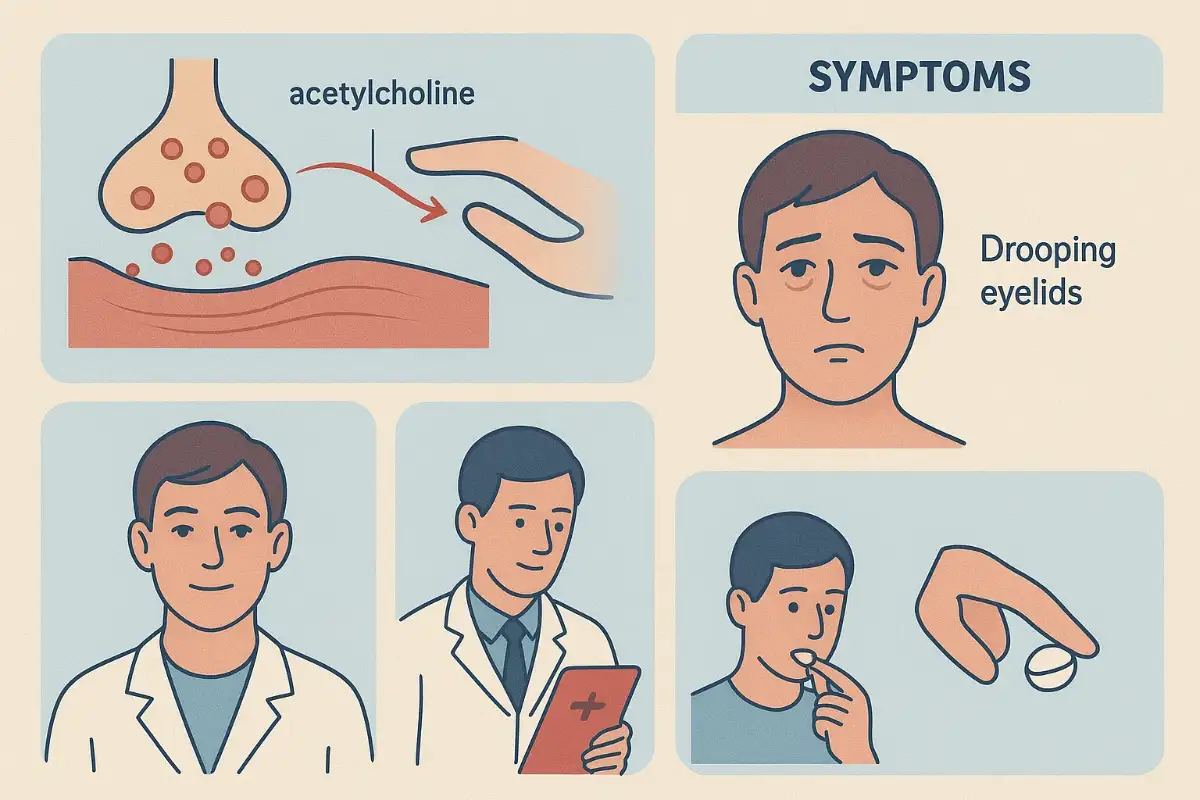Essential Facts About Myasthenia Gravis
MG is a chronic autoimmune condition in which the body’s immune system produces antibodies that block communication between nerves and muscles, causing human muscles to become weak.
The condition primarily affects voluntary muscles, especially those involved in eye movement, facial expressions, speech, swallowing, and arm or leg movements.
Although MG can develop at any stage of life, it is more common in women in their 20s and 30s and men over the age of 50.
During flare-ups, individuals may experience difficulty swallowing or breathing, which can be severe.
The exact cause is still unknown, and there is currently no permanent cure. However, recognizing the symptoms early and starting proper treatment can significantly improve quality of life and help patients perform daily tasks for many years.
Introduction: What is MG—The Silent Muscle Killer
MG is a rare neuromuscular disorder that progressively weakens the voluntary muscles of the body. In MG, the immune system mistakenly blocks nerve signals, causing the muscles to become tired and not function properly. The biggest problem with this disease is that in the early stages people consider it normal fatigue, but if not diagnosed timely, then MG can be dangerous.
Causes: Why does mG occur?
The main cause of MG is an autoimmune reaction. Normally, nerve cells release a chemical messenger called “acetylcholine” that signals muscles to contract. But in MG, the immune system’s antibodies block the acetylcholine receptors.
In some cases, abnormal growth of the thymus gland (thymoma) also causes MG . Patients with genetic predispositions and other autoimmune disorders have a higher risk of developing MG.
Symptoms: First signs of mG
The first and most common symptom of MG is muscle weakness, which improves with rest.
- Eye symptoms: Drooping of the eyelids (ptosis), double vision
- Face & neck: Difficulty in speaking, a weak attachment for smile
- Arms & legs: Tiredness while lifting weights
- Throat muscles: Problems swallowing food, choking
- Respiratory muscles: Difficulty in breathing
These symptoms may worsen during the day and improve slightly with rest, but MG can gradually become severe.
How Myasthenia Gravis Affects Daily Life
MG is not just a medical diagnosis but has a direct impact on the patient’s everyday life. Eye symptoms such as double vision and eyelid drooping make driving, reading, and computer work difficult. Weakness in the face and throat muscles makes swallowing food difficult, which may require patients to eat a soft or liquid diet. Weakness in the arms and legs makes even simple tasks such as lifting groceries, putting on clothes, or climbing stairs challenging. MG patients may need to take multiple rest breaks throughout the day as fatigue can increase rapidly.
Risk factors: Who is more likely to be affected?
Anyone can develop MG , but some people are in high-risk groups:
- Women aged 20-40 years
- In 50+ years
- Patients with other autoimmune disorders (thyroid problems, lupus)
- Family history of MG
- Thymus gland abnormalities
Diagnosis: How to recognize myasthenia gravis?
Doctors use some special tests to diagnose MG:
- Blood test: to check for antibodies
- Electromyography (EMG): To check for nerve-muscle signals
- CT/MRI scan: To check the size of the thymus gland
- Ice pack test: To see temporary LED improvements
Early diagnosis plays a crucial role in the treatment of MG.
Treatment: Treatment of mG
There is currently no permanent cure for MG, but treatments can control the symptoms:
- Medications: Drugs such as pyridostigmine improve nerve-muscle connections
- Immunosuppressants: Prednisone and azathioprine work to stop immune attacks.
- Plasmapheresis & IVIG: Removing antibodies from the blood
- Thymectomy: removal of the thymus gland
Lifestyle changes also help in managing MG—reducing stress, eating a balanced diet, and getting enough rest.
Living with MG: Self-Care & Lifestyle Tips
Living with Myasthenia Gravis: Self-Care & Lifestyle Tips
Living with MG can be challenging, but certain lifestyle habits can help keep symptoms under control. Ensure adequate rest, avoid overexertion, and maintain a balanced diet with proper hydration. The National Institute of Neurological Disorders and Stroke (NINDS) recommends adopting stress management techniques such as yoga, meditation, and light exercise. Take your prescribed medications on time and never skip regular check-ups with your doctor.
Living with Myasthenia Gravis: Self-Care & Lifestyle Tips
Living with MG can be difficult, but some lifestyle changes can help manage the symptoms. It is important to take adequate rest and manage your energy levels wisely. Overexertion should be avoided, as excessive physical activity can trigger weakness. Focus on a balanced diet, hydration, and infection prevention (mask use, hygiene). Stress management techniques such as yoga, meditation, or light stretching exercises can reduce MG flare-ups. Don’t miss your doctor’s follow-up appointments, and take prescribed medicines on time.
Complications: Myasthenic Crisis
The most serious complication of MG is myasthenic crisis, in which the patient has extreme difficulty breathing. This situation is an ICU-level emergency and may require ventilator support. If an MG patient has sudden problems in breathing or swallowing, he should go to the hospital immediately.
Prevention & Prognosis
MG cannot be completely prevented because it is an autoimmune disorder. But with early diagnosis and timely treatment, MG patients can lead a normal life.
Avoiding infections, stress management, and proper medication improves the prognosis.
Myasthenia Gravis Myths vs Facts
People have many misconceptions about MG . A common myth is that it only occurs in the elderly, but the fact is that it can develop in any age group. Another myth is that it is a contagious disease, whereas MG is not at all infectious—it is an autoimmune disorder. Some people think that its patients cannot lead a normal life, whereas with proper treatment and lifestyle management, MG patients can lead an active and healthy life.
Read Also: Lake Tahoe Plague: Bubonic Plague Symptoms, Causes, and Safety Guide
Conclusion
MG is a rare but potentially life-threatening disease that disrupts nerve-muscle communication. Do not ignore every symptom, especially if the weakness improves after taking rest. Timely diagnosis and treatment of MG can help patients live a healthy and active life.






